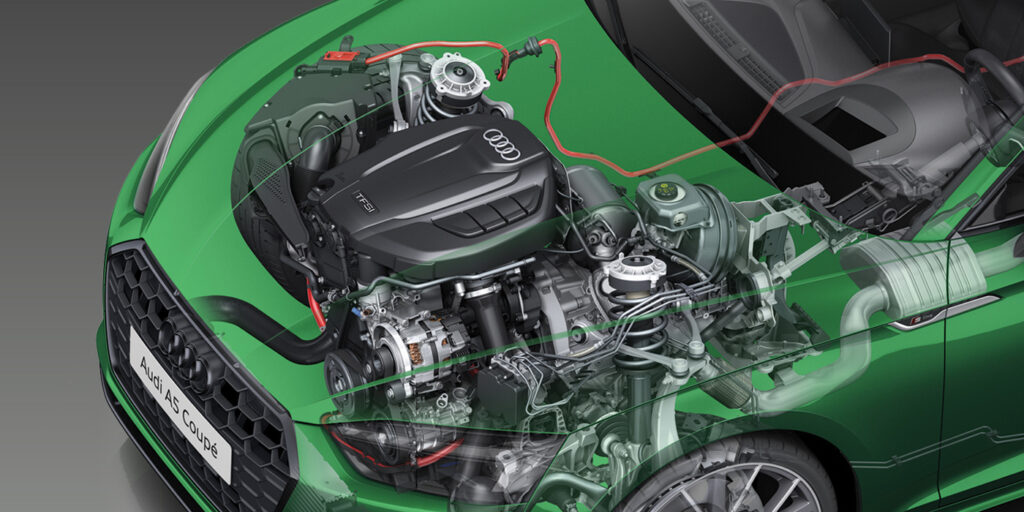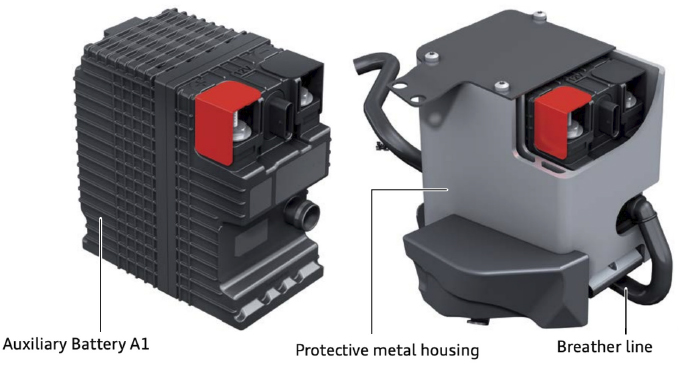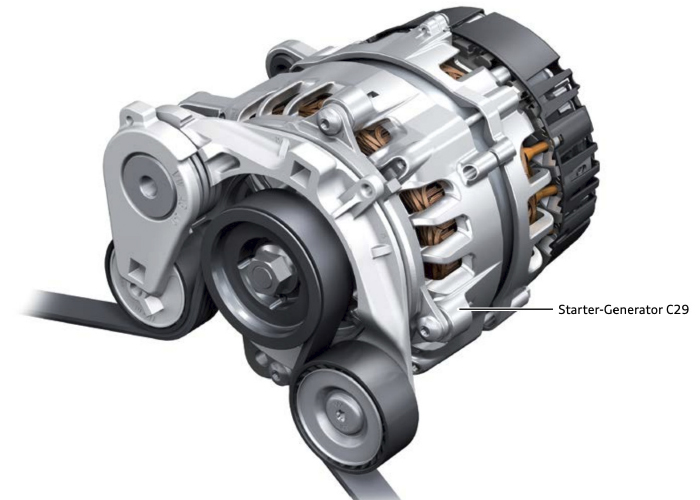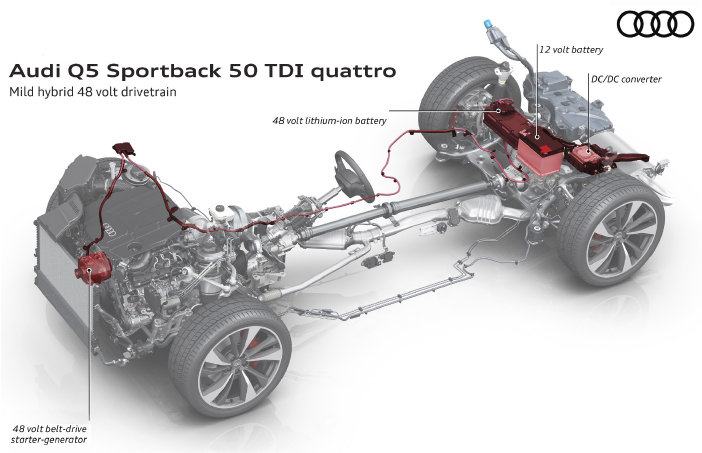You probably think about bulky battery packs and electric motors between the engine and transmission when I say hybrid. But, new mild hybrid electric vehicle systems, or MHEV, from Audi are redefining the category. Many Audi models after 2018 have this system as standard.
Audi has both 12-volt and 48-volt MHEV models and they use a combination alternator and starter. The 12-volt system can be found on some four-cylinder models, and the 48-volt system can be found on V6 engines. You can tell if it is a 48-volt system if the alternator/starter combo is cooled with coolant.
Both units are connected to the crankshaft pulley using a belt. A separate 12- or 48-volt battery is used to store power. While the 12-volt system can’t propel the vehicle on its own like the 48-volt system, it can apply power to improve fuel efficiency at cruising speeds.
While the new systems have benefitted from improved battery technology, the big story is how the system has been integrated into the vehicle’s architecture for power management, ADAS and navigation.
The Audi MHEV essentially has two electrical systems that work together. The 12-volt system operates all of the standard vehicle components like the fuel injection, ignition and other components that use 12 volts. The other 12- or 48-volt system powers the starter/alternator hybrid system. Both systems work together to manage the energy and state of charge of the two batteries. On more powerful systems, the 48-volt system converts power to 12 volts. This gives a new level of redundancy to the starting and charging system.
There is a 12-volt AGM battery that can be mounted in various locations depending on the model. This is typically called “Battery A” in the service information. The auxiliary battery is named “Battery A1.” It can also be mounted in a variety of locations.
Auxiliary Battery A1 is connected in parallel to the 12-volt battery. It has an internal relay that controls its connection to the electrical system. Its relay is closed during the start procedure or shortly after.
The 48-volt battery can charge the 12-volt battery when the engine is off. If a 12-volt battery charger is connected, it will transform it to 48 volts to charge the other battery. The same strategy is used for the 12-volt MHEV. It is recommended to use only a battery charger designed for AGM batteries that keeps the voltage below 15 volts or lower.
Auxiliary Battery A1 is connected in parallel to the AGM A battery. Its relay is closed during the start procedure or shortly after. If the ignition is switched off, the relay is opened and A1 is disconnected from the electrical system. In certain operating conditions, such as for the duration of the continued operation of the radiator fans or the auxiliary pump, the relay may remain active after Terminal 15 has been deactivated.
What does this mean for battery inspection? To inspect the batteries, you will need a scan tool to communicate with the battery energy management system (BEMS) and the hybrid system. Both batteries have multiple sensors that measure the current going into and out of the batteries. The system communicates with the modules on the vehicle and measures the voltage drop or draw on the battery. If an ABS correction happens, it can sense if the battery recovers under the strain. Both batteries also monitor the temperature inside the battery. With this information, the vehicle can estimate the battery’s life and alert the driver before it leaves them stranded. If the 12-volt battery is replaced, you must program the BEMS to recognize the fresh battery.
Starters
The Audi MHEV systems have two starters. Both MHEV have a conventional 12-volt starter that engages the flywheel like internal combustion models. It is used to start the engine at engine oil temperatures of less than 113° F.
The starter and alternator combo can also start the engine but under specific conditions. Its electric motor function is used to start the engine when the engine oil temperature is above 113° F (45° C) and in start/stop mode. Because of the connection via the poly V-belt, the stop/start function is smoother than a conventional starter.
Maintenance
Since starting and power generation is performed using the integrated starter and generator, the belt is under a lot of stress. The belt has a recommended service interval of 60,000 miles and should be inspected every oil change, according to Audi. Some owners have reported the belt can wear out before the recommended interval, depending on the driving habits.
Here is the good news: Audi MHEVs have the same maintenance intervals as internal combustion Audi vehicles. They need oil changes and regular transmission maintenance to function.
Diagnostics
With MHEV vehicles, a high-quality scan tool is essential to diagnose problems and codes. But, service information is critical to check if the system is operational.
For the stop/start function to work, specific criteria must be met. For example, to check certain functions, the driver’s seatbelt must be fastened, and the door must be closed. Other criteria like engine temperature and drive cycle need to be researched to test the systems and monitors.
The latest Audi models share data from the ADAS system to maximize the hybrid and stop/start functionality. Cameras and radar sensors can be used to detect if a light has turned green and the traffic has started to move. This can allow the engine to start before the driver releases the brake pedal. Combined with GPS data, the control systems can decide if it is efficient to use the 48-volt starter on a freeway.

















